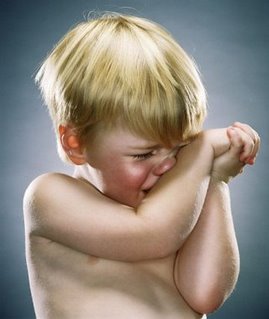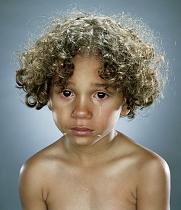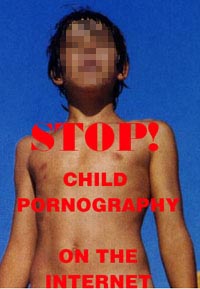T.O.P. Photographer of the Year 2006
Jill Greenberg
Jill Greenberg
"Getting kids to cry isn't the nicest thing to do." The words are Jill Greenberg's.
 In 2006 we were treated to what passes for a controversy in contemporary photography. Greenberg, a commercial studio portraitist from Beverly Hills—she had previously gotten attention from the art world for a series of beautiful studio portraits of monkeys and apes (right)—made a small series of pictures of young children crying. (A small exhibition catalog was published called End Times.) A blogger named Thomas Hawk (a pseudonym—his real name has been "outed," though I don't see any reason to repeat it here, since bloggers have a right to present themselves as they wish to be presented) wrote an inflammatory protest about the pictures, making charges of child abuse, among other things, and the argument has simmered incessantly from the blogosphere to the New York Times Magazine, including criticisms ranging all the way to death threats against Greenberg (that's a bit much) to outraged defenses of her by the owner of her gallery and her husband, some of which were later withdrawn.
In 2006 we were treated to what passes for a controversy in contemporary photography. Greenberg, a commercial studio portraitist from Beverly Hills—she had previously gotten attention from the art world for a series of beautiful studio portraits of monkeys and apes (right)—made a small series of pictures of young children crying. (A small exhibition catalog was published called End Times.) A blogger named Thomas Hawk (a pseudonym—his real name has been "outed," though I don't see any reason to repeat it here, since bloggers have a right to present themselves as they wish to be presented) wrote an inflammatory protest about the pictures, making charges of child abuse, among other things, and the argument has simmered incessantly from the blogosphere to the New York Times Magazine, including criticisms ranging all the way to death threats against Greenberg (that's a bit much) to outraged defenses of her by the owner of her gallery and her husband, some of which were later withdrawn.I wrote in my magazine column recently about the uneasy relationship between ideas and their names, and between ideas for pictures and the pictures themselves. The fact is, sometimes a good idea doesn't result in very good pictures, and sometimes a fairly stupid idea can lead to great pictures. I think Jill Greenberg's idea—the nominal notion is that the Bush Administration is making the future cry—probably shades more toward the latter than the former, but I'll let Jill speak for herself, from an interview in American Photo magazine:
American Photo: How did you come up with the idea for the project?
Jill Greenberg: "I saw this little girl who'd come to a party with her mom, and she was beautiful, so I thought it might be interesting to photograph her. When they came to my studio, the mother brought along her toddler son, and I decided to shoot him too. We took off his shirt because it was dirty. He started crying on his own, and I shot that, and when I got the contact sheets back I thought, "This could go with a caption, 'Four More Years,'" like he was appalled at George Bush's reelection. The images have a real power—they immediately get under your skin. The emotion you see is just so compelling, yet they're beautiful at the same time. That was one of the things that interested me about the project—the strength and beauty of the images as images. I also thought they made a kind of political statement about the current state of anxiety a lot of people are in about the future of the country. Sometimes I just feel like crying about the way things are going."
It's not for me to try to put in the last word on the controversy, and I wouldn't put a cap on it even if I could: reacting to photographs is the right of every viewer, and I would no more seek to suppress the outrage of those who feel outrage than I would seek to censor the pictures. It's been widely noted that Ms. Greenberg and Paul Kopeikin, of Kopeikin Gallery in Los Angeles, have benefitted from the publicity: the prints of the crying babies sell for thousands of dollars each, and, I'm told, sales have been brisk. Personally, I can think of two dozen things more obscene than a crying child that are photographed every day, and as a parent I'm not particularly upset about the idea of making a child cry, although I agree that it isn't the nicest thing to do. I probably wouldn't have had the heart for such a project myself. But one thing I will say is that photographers often show things that non-photographers would prefer not to look at, or at least would not choose to commemorate. It's always been thus, and it ever will be.
What I think has been overlooked is that the pictures themselves are amazing, and not like anything you've ever seen before. Jill Greenberg has developed a style that is almost Koonsian* in its shiny, sculptural plasticity, perfect for the emotional remoteness of her postmodernistic gaze. It's perfected and distanced from perfection at the same time. The pictures themselves are beautiful and original, familiar and moving and yet still strange and new. They certainly encapsulate, just perfectly, an ambivalence between looking and not looking, between objective aesthetics and subjective empathy.
Encouraging people to think, and encouraging immediate, visceral—and, moreover, personal—responses are a big part of what art's all about. For managing that (perhaps to a greater extent than she'd bargained for) while at the same time bringing new vitality to the modus of the classic, straightfoward head-and-shoulders studio portrait, Jill Greenberg is T.O.P.'s Photographer of the Year for 2006.
Posted by: MIKE JOHNSTON
* The reference, in case it's unfamiliar to you, is to the American artist Jeff Koons.
UPDATE: As a corrective to some of the more hysterical comments I got about this post, I thought a little moral and emotional calibration might be appropriate.
This is an injured child:

This is not an injured child:

This is brutality:

And this isn't:

This is neglect:

This isn't:

This is an atrocity:

This isn't:

Child pornography exists,

But this isn't an example of it...

And so forth. Do I need to go on? (I'm sorry to say that in poking around the web for these, I stumbled on a picture that truly shocked me, of a child of about four performing fellatio on a grown man. I'm sorry I saw it myself, sorry I now have that in my head—and sorry that crimes like that are committed on any child. But needless to say, that's exploitation, and it's on a different moral plane altogether from watching a healthy kid cry for five minutes.)
Mind you, in objecting to the polarizing tendencies of others, I hope I'm not polarizing myself here—there is an element that is distressing and, yes, even a little disturbing (in the sense of not-quite-right) in Greenberg's pictures. I can sympathize with people who are villifying and even demonizing Greenberg, to an extent. But what they're talking about are their own feelings, not anything objective about the children, or their parents, or the photographer.
There is another issue no one has broached yet. To me, there is also something a little disturbing about people who reserve their strongest outrage and disapproval for relatively benign, palatable transgressions, while remaining silent about things people really ought to speak up about if they have the freedom to. I can't, and won't, paint any individual reading this with that brush; obviously, no one has expressed the entire range of their moral positions, nor do we need to in order to comment on one issue. But do you know what I mean? It's like people who express deep outrage about dead cat jokes and then keep silent about the millions of healthy cats that are euthanized every year. It's a form of moral displacement. There's something a little off about that, too.
But back to the pictures—I'm getting pretty far afield. We've heard a lot about how Greenberg's political associations are just dumb (I agree) and that the End Times pictures are kitschy (they sort of are, but in a good way—anyway, you try it), but one thing no one has done yet is this: propose another set of pictures made during 2006 that is more memorable, or that has been as much a part of the visual zeitgeist of the times during the past year. That's a comment I'd like to read.
—M.J.
Comments are now closed for this post—thanks. (Bob Walters either summed everything up or brought them to a new low, I don't know, but I'm feeling a bit traumatized by all the disputation. Being the "comment gatekeeper" is the worst thing about blogging....)

0 comments:
Post a Comment